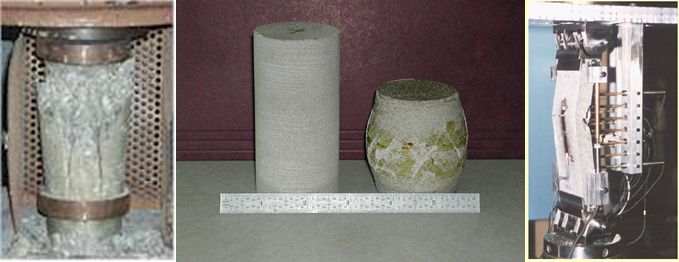Concrete and Geomaterial Modeling with LS-DYNA

Introduction to Geomaterials - Video
First 16 minutes of 1 hour presentation - View Full Screen
Concrete and Geomaterials Class Description (PDF Download)
Course Description
Constitutive models for concrete & geomaterials (rock and soil) are typically based on the same mathematical plasticity theory framework used to model common metals. However, the constitutive behavior of concrete & geomaterials differs from that of metals in three important ways:
- They are (relatively) highly compressible, i.e., pressure-volume response;
- Their yield strengths depend on the mean stress (pressure), i.e. frictional response; and
- Their tensile strengths are small compared to their compressive strengths.
The course starts from the common ground of introductory metal plasticity constitutive modeling and successively builds on this base adding the constitutive modeling features necessary to model concrete & geomaterials. The LS-DYNA constitutive models covered are adequate for modeling most types of rock, all concretes, and a large class of soils. The course is intended for those new to concrete & geomaterial constitutive modeling, but will also be useful to those seeking a more in-depth explanation of the LS-DYNA concrete & geomaterial constitutive models covered.
A significant portion of the course is devoted to understanding the types of laboratory tests and data that are available to characterize concrete & geomaterials. Unlike most metals, whose strength is characterized by a single value obtained from a simple uniaxial stress test, concrete & geomaterial characterization requires a matrix of laboratory tests. Knowledge of how these tests are performed, the form and format of typical laboratory test data, and the interpretation of the data for use with a concrete or geomaterial constitutive model, is essential to becoming a successful concrete & geomaterial modeler.
The basic mathematics of the LS-DYNA concrete & geomaterials constitutive models are covered, with an emphasis on how the mathematics can aid the modeler in fitting constitutive models to the available laboratory data. The mechanics of the constitutive model are emphasized to provide the modeler with the insights necessary to easily separate cause and effect in these complicated constitutive models. Exercises in fitting the LS-DYNA concrete & geomaterial constitutive models to typical laboratory data are used to illustrate the data and the constitutive models.
Several application case studies are covered:
- Quasi-static soil penetration,
- Quasi-static eccentric loading of a reinforced concrete column
- Penetration of a concrete target using Lagrange with erosion, Eulerian and SPH formulations.
- Blast loading of a reinforced concrete slab modeled with several concrete models.
Course Materials
The course notes consist of over 300 pages of descriptive text, presented in a narrative style, i.e. not a collection of presentation slides, arranged in more than 20 sections that include the exercises and their solution. Participants are offered the LS-DYNA input files for all examples, and Microsoft Excel workbooks containing the laboratory data for several materials, including a sandy soil, Salem limestone, and two concretes.
Daily Class Schedule
Day 1
- Introduction to Metal Plasticity
- Nomenclature
- von Mises Constitutive Model (Material Type 3)
- Perfect Plasticity and Hardening
- Third Stress Invariant and Failure
- Overview of a Numerical Constitutive Model Algorithm
- Tresca Yield Criterion
- Description of the Pi-Plane
- Two Special Limiting Cases for the Lode Angle
- Introduction to Geomaterials
- Compressibility the Pressure – Volume Response
- Pressure Enhanced Shear Strength – Frictional Materials
- Mohr-Coulomb Failure Criteria
- Soil and Foam Model (Material Type 5)
- Appendix: Engineering and True Stress-Strain
- Material Characterization - Laboratory Tests & Data
- Hydrostatic Compression Testing
- Tri-Axial Compression Testing
- Other Useful Material Tests
- Exercises - Calibrating the Soil & Foam constitutive model (MAT005) to low and high pressure soil data.
- Case Study - Quasi-static Soil Penetration.
- *MAT_PSEUDO_TENSOR (MAT016)
Day 2
- Simple Input Concrete Models:
- *MAT_PSEUDO_TENSOR (MAT016 - Mode II Concrete)
- *MAT_CONCRETE_DAMAGE_REL3 (MAT072R3)
- *MAT_WINFRITH_CONCRETE (MAT085)
- *MAT_CSCM_CONCRETE (MAT159)
- *MAT_RHT (MAT272)
- *MAT_CDPM (MAT273)
- Case Studies using Simple Input Concrete models
- Reinforced Concrete Column - Eccentric Loading
- Brick Wall Perforation
- Concrete Target Perforation - SPH, MM-ALE & Erosion
- Blind Blast Simulation Contest
- Modeling Reinforcement
- Winfrith Concrete Model - Crack Patterns
- Strain Rate Effects – Much Ado About Nothing?
- Introduction to the LS-DYNA Cap Models - Calibrating the Geological Cap (MAT025 25)